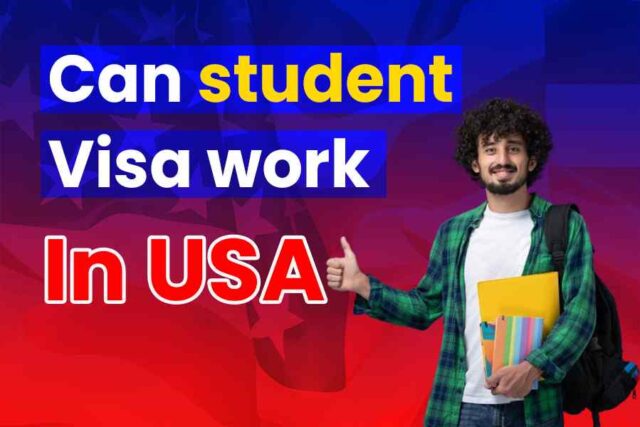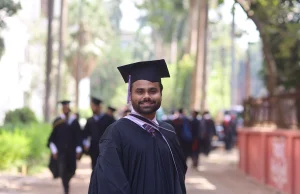If you’re an international student in the United States, you may want to know, “Can a student visa work in the USA?” You might want to find a job to gain work experience, help with your tuition, or earn extra cash.
However, it’s essential to understand that as an international student on a F-1 visa, you cannot just take any job you want. There are rules you need to follow. Breaking these rules can have serious consequences. The US government doesn’t take working illegally lightly. It could put your student visa at risk and even result in deportation.
In this article, we’ll guide you through the basics of getting permission to work while studying in the US.
Can A Student Visa Work In The USA?
Most international students studying in the US have an F1 visa. It is a United States non-immigrant student visa. This visa is for students admitted to US high schools, universities, language training programs, colleges, and other academic organizations.
Students with an F1 visa can work in the US but must follow specific rules and regulations. These rules are set by the USCIS (U.S. Citizenship and Immigration Service) and can be pretty complicated. Generally, students can do any job as long as they adhere to the rules and regulations of their F1 visa.
What Are The Work Opportunities For A Student Visa In The US?
In the U.S., F-1 students have limited job options. That is why, before coming to the U.S., they need to show they can afford school and living costs. They do this by showing bank statements proving they have enough money.
If you like to work, the first thing to do is talk to your DSO (Designated School Official). They’re the ones your school picked to help international students. If you’re already a student, you probably met your DSO when you reached the US.
If you haven’t met your DSO, any school staff can direct you to them or their department. Your DSO will assist you in applying for a Social Security Number, which you will need to work in the US. They’ll walk you through all the appropriate steps.
If your DSO finds out you’re working without permission, they must report it via SEVIS (Student and Exchange Visitor Information System). That means your SEVIS record gets terminated. You’ll have to leave the U.S. immediately and might not be allowed back.
During your time as an F1 student in the U.S., you can explore different job options. Your eligibility for these jobs depends on your status and what you’re studying. Here are the types of jobs you might be able to do while you’re studying in the U.S:
- On-Campus Employment
- Optional Practical Training (OPT)
- Curricular Practical Training (CPT)
- Severe Economic Hardship
- Employment with an International Institution
On-Campus Employment
USCIS regulations allow on-campus jobs freely without the need for USCIS approval. Even though F1 status permits on-campus employment, most schools have limited job options. Even if you get an on-campus job, you should only count on it to cover some of your yearly expenses. These jobs often are different from what you’re studying.
Before taking any on-campus job, many schools ask you to get permission from your International Student Office. Some schools might not allow first-semester or first-year students to work on campus.
Your student status depends on your school’s support, so getting clearance and guidance from your International Student Office is crucial before applying for or accepting a job. They can help you understand unclear situations and follow proper procedures.
Your school’s guidance is also essential for filling out the necessary forms with USCIS and getting any necessary approval from USCIS.
On-campus employment means working either on your campus or at an “educationally affiliated place.” The Department of Homeland Security states that for an off-campus location to be “educationally affiliated,” it needs to fulfill one of the two criteria below.
Linked with the established curriculum of the school.
Associated with the post-graduate level research projects that are funded contractually.
It’s important to highlight the second part of that definition because numerous colleges and universities spread their buildings and educational collaborations throughout the town.
In simple words, you can work right on your school’s campus, like in a cafeteria, bookstore, dorm, or library. Alternatively, you could work at an off-campus research lab connected to your school.
Rules For On-Campus Work For An F1 Student
- You need to keep your F1 status valid.
- The job cannot replace a living position held by a U.S. resident.
- You can work twenty hours each week when school is in session.
- If you plan to enroll in the next academic semester, you can work full-time at your school during vacation breaks and holidays.
Optional Practical Training (OPT)
International students studying in the United States on an F1 visa can work off-campus through optional practical training (OPT) during and after their degree. The United States Citizenship and Immigration Service (USCIS) sets the rules for OPT. You need approval from USCIS and the International Student Office of your school for any OPT job.
You can apply for optional practical training after 9 months of enrollment. However, you can only start working once you get your EAD (Employment Authorization Document) from USCIS and have been admitted for one year.
You can apply for your OPT Employment Authorization Document (EAD) without having a job offer beforehand, and you’re free to work anywhere in the United States. But be proactive—USCIS might take up to three months to process your application. So, applying early and contacting your school’s International Student Office for guidance is wise.
Remember, following the rules is vital to maintaining your F1 visa, and your International Student Office is available to support you throughout your time in the U.S.
When traveling as an F1 student on OPT, be cautious of the rules. If you leave the U.S. after finishing your degree but before getting your EAD and securing a job, you might not get readmitted. However, if you’ve got your EAD and work, you can leave and return, but remember to bring all the necessary documents for re-entry.
The Department of Homeland Security changed OPT rules for students in specific fields in 2008. Now, eligible students can extend their OPT for an extra 17 months after completing their student’s degree. However, this extension is available for students working for a company enrolled in the E-Verify program.
Make sure you’re studying one of the below subjects to take advantage of this extension:
- Actuarial Science
- Life Sciences
- Computer Science Application
- Engineering
- Physical Sciences
- Engineering Technologies
- Military Technologies
- Mathematics
General Requirements for OPT
- Your job during OPT must be closely related to what you studied in school.
- Apply for OPT before finishing all your degree requirements.
- If you’ve done twelve months or more of full-time CPT (Curricular Practical Training, you can’t do OPT.
- It’s essential to keep your F1 status legal.
- You can work full-time on OPT for up to 12 months total. Working part-time while still in school will affect how much full-time OPT you have left. Part-time work cuts into your available full-time work by half the amount of part-time work you did. For example, if you worked part-time for 6 months, you can do full-time OPT for up to 9 months.
Rules For OPT After Completion Of A Degree
- After completing your degree, your OPT job must be full-time, meaning you must work 40 hours per week.
- Make sure to send your post-completion OPT application to USCIS before you finish your degree.
- You have to finish all your OPT work within 14 months after completing your degree.
Rules For OPT Before Completion Of A Degree
- Students need to be admitted to school full-time.
- If a student has finished all their coursework but still need to complete a dissertation or thesis and is making average progress toward their degree, they can work full-time.
- Students can only work up to 20 hours each week during the school session.
- When school is off for summer or other breaks, students can work full-time as long as they plan to return to school afterward.
Curricular Practical Training (CPT)
Curricular Practical Training (CPT) lets F1 students work off-campus when the training is a crucial part of their academic or curriculum program. CPT jobs include cooperative education, internships, alternative study/work, or other required training or internships offered by employers working with your school.
To be eligible for CPT, your degree program must require work experience, or you must earn academic credit for it. You will get payment for CPT jobs. However, you first need approval from your International Student Office and to notify the USCIS.
Your school’s International Student Office needs to approve you for CPT. After approval, you can work for the particular employer on the dates they set. It is different from severe economic hardship off-campus jobs or OPT, where you can work anyplace in the United States.
Your CPT approval will indicate if you can work full-time (over 20 hours each week) or part-time (20 hours or less). During school sessions, you can get approval for part-time CPT.
Whether you get approval for part-time or full-time on CPT, there’s no limit to your work tenure. But if you do full-time CPT for twelve months or more, you can’t do OPT afterward. If you do full-time CPT or part-time CPT for less than twelve months, you can still do all the OPT jobs you’re allowed. Just keep an eye on the hours and dates so you don’t mess up your OPT.
Requirements for CPT
- You must have been admitted full-time in school for at least one year under valid F1 status. However, if you’re a graduate student and your program needs immediate CPT, this rule doesn’t apply.
- Your CPT job must be a necessary portion of your degree program or required for a course where you earn academic credit.
- Before you request CPT authorization, you need a job offer that meets the qualifications.
- Your job offer must be related to your field of study.
Severe Economic Hardship
If you’re an F1 student facing severe money problems, you can work off-campus for 20 hours a week while classes are on and full-time during holidays, according to USCIS rules. To qualify, you must be experiencing severe financial difficulties due to unexpected situations beyond your control. These situations include:
- A significant increase in living or tuition costs that you weren’t prepared for.
- Losing on-campus jobs or financial aid through no fault of yours.
- Substantial medical bills or unexpected expenses that you didn’t see coming.
- Your financial support source suddenly changes, like if your family can’t help as much as before.
- Exchange rates or the value of money fluctuate a lot.
You should work with your school’s International Student Office to get an EAD (employment authorization document). This document is needed to start work. They’ll assist you with any documents or forms you need.
Eligibility Criteria for Severe Economic Hardship
- You must provide evidence showing economic hardship due to unexpected circumstances beyond your control.
- You need to have good academic standing.
- You must maintain a valid F1 visa for one academic year.
- Before applying, try to find employment on campus.
- You should demonstrate that there are no available or sufficient on-campus job opportunities.
Employment With An International Institution
The last option for international students in the United States on student visas is working for a “well-known international institution.” The institution needs to be on the State Department’s official list to be eligible.
This list includes the World Trade Organization, Red Cross, and World Health Organization, along with less well-known institutions.
This job option often gets overlooked since it doesn’t contain the universal application of CPT or OPT. Students with a sponsorship from listed institutions or a job offer can qualify. However, this job category offers some clear advantages for those fortunate students who do receive that sponsorship.
You can request an EAD (Employment Authorization Document) from the USCIS. Remember that you can only start working once you have your EAD, and it might take 3 months to get it.
Requirements to Do a Job for an International Institution
- The student needs to have employment or internship with a “well-known international institution.”
- The job must fall within the institution’s sponsorship and match the student’s area of study.
- The student should have good academic standing.
- The student must have maintained a valid F1 visa for one academic year.
Conclusion
Can a student visa work in the USA? Yes, you can work in the United States on a student visa. However, as you start looking for a job, remember that working without the proper authorization can result in deportation and prevent you from returning to the US.
It’s not worth taking the risk. You have put in a lot of effort and money to study in the United States. So, make use of the resources that you have to find legal employment, beginning from your school.














